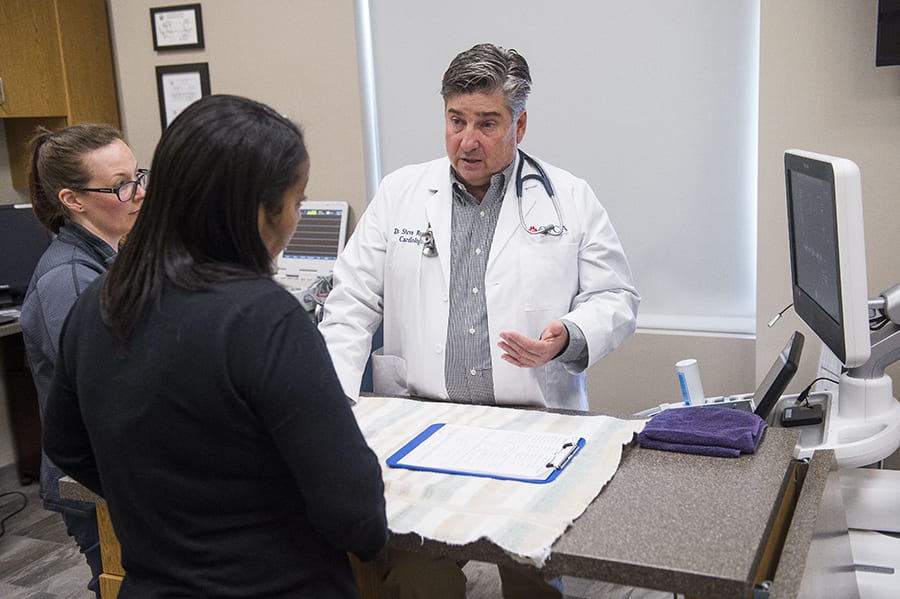What You Required to Understand About Veterinary Providers: A Summary of Diagnostic Tools and Procedures
Vet services play a vital function in keeping the health and wellness of pets. Routine check-ups can expose hidden wellness issues beforehand. Different analysis tools and treatments, such as blood tests and imaging methods, provide vital insights right into an animal's wellness. Recognizing these methods is vital for animal proprietors. What specific diagnostic treatments are most commonly utilized, and just how can they impact an animal's therapy strategy?
Significance of Routine Vet Check-Ups
While numerous pet dog proprietors may undervalue the value of regular veterinary examinations, these consultations are important for preserving a pet's total health. Routine sees to the vet enable early detection of prospective health and wellness concerns prior to they escalate into major troubles. Normal check-ups typically consist of inoculations, which are necessary for avoiding infectious conditions that can significantly influence a pet dog's health. Additionally, these consultations give an opportunity for vets to analyze the pet's weight, dental wellness, and overall problem, making sure that the pet dog is thriving. During these sees, pet owners can likewise receive important recommendations on diet, workout, and precautionary treatment tailored to their particular animal's needs.
Typical Diagnostic Procedures in Vet Medicine
In veterinary medicine, accurate diagnosis is crucial for effective treatment. Common analysis procedures consist of blood screening strategies, progressed imaging modern technologies, and urinalysis, each playing a considerable function in identifying health concerns. Recognizing these techniques enhances the capability to give appropriate look after animal patients.
Blood Evaluating Methods
Blood screening methods act as vital analysis devices in vet medicine, making it possible for veterinarians to analyze the health and wellness of pets accurately. These methods entail collecting blood samples to examine numerous elements, such as white and red blood cells, platelets, and biochemical pens. Usual tests consist of total blood matters (CBC), which review overall wellness and detect infections, and biochemical panels, which evaluate organ feature and metabolic status. In addition, serological examinations can identify details illness via antibody detection. Blood screening is minimally intrusive and provides crucial details that aids in identifying conditions, monitoring wellness standing, and evaluating actions to treatments. On the whole, these methods play a vital duty in making sure excellent take care of pet dogs and livestock alike.
Imaging Technologies Used
Diagnostic imaging modern technologies are important tools in veterinary medication, matching blood testing strategies by giving aesthetic insights into an animal's inner frameworks. Common imaging modalities consist of X-rays, which work for evaluating bone fractures and finding international items, and ultrasound, which permits for real-time visualization of soft tissues and body organs. Magnetic vibration imaging (MRI) offers thorough photos of complicated physiological locations, particularly in neurological analyses. Calculated tomography (CT) gives cross-sectional images, enhancing analysis precision for numerous conditions. Each of these modern technologies help veterinarians in identifying ailments, intending treatments, and keeping an eye on recuperation. By incorporating imaging innovations, vet experts can better analyze a pet's health and make notified choices regarding their care.
Urinalysis and Diagnostics
Urinalysis serves as an important analysis tool in veterinary medicine, offering useful understandings into a pet's general health and helping in the detection of different problems. This non-invasive procedure analyzes urine samples to assess kidney feature, hydration condition, and metabolic problems. Usual elements analyzed include certain gravity, pH levels, sugar, healthy proteins, and the visibility of blood or microorganisms. Unusual searchings for can show issues such as urinary system system infections, diabetes mellitus, or kidney illness. To enhance diagnostic precision, urinalysis is typically executed in conjunction with various other tests, such as blood work and imaging studies. Early detection via urinalysis can bring about prompt treatments, improving the diagnosis for many veterinary individuals. It is an essential aspect of extensive vet care.
Understanding Blood Examinations and Laboratory Analysis
Recognizing blood tests and laboratory analysis is essential in veterinary medication as it aids in diagnosing numerous health problems in pets. Different kinds of blood examinations supply important info regarding an animal's internal state, while translating lab results needs cautious consideration of countless elements. This area will check out the kinds of blood examinations readily available and the importance of their results.
Sorts Of Blood Tests
Blood examinations play a vital role in vet medication, offering crucial understandings into an animal's health status. Various kinds of blood tests are used, each offering various objectives. Full blood matters (CBC) analyze overall health and identify conditions such as anemia or infection. Biochemical profiles examine organ function by measuring enzymes and electrolytes, using insights right into metabolic health. Serological examinations determine particular antibodies or virus, helping in the medical diagnosis of infections or autoimmune diseases. Blood typing warranties risk-free transfusions, while coagulation tests assess the blood's capability to clot, essential for surgeries. These tests collectively boost medical diagnosis, therapy preparation, and monitoring of an animal's health and wellness, illustrating the relevance of thorough lab analysis in vet treatment.

Translating Laboratory Outcomes
An extensive evaluation of laboratory results is crucial for exact diagnosis and treatment in vet medication. Translating lab results needs an understanding of regular referral arrays and the significance of deviations. Blood examinations can expose various health and wellness indications, such as organ function, electrolyte equilibrium, and the existence of infections. Vets have to take into consideration the entire clinical image, consisting of the animal's history, physical evaluation findings, and any symptoms provided. Variants in outcomes may develop from elements such as age, type, and underlying health problems. Subsequently, laboratory outcomes need to not be seen alone however rather as part of an all-encompassing diagnostic method. Exact analysis enables customized More hints therapy strategies and better end results for vet individuals.
Imaging Techniques: X-rays, Ultrasounds, and Beyond
Imaging techniques are vital devices in vet medication, providing critical understandings right into the health and well-being of pets. Amongst one of the most frequently used techniques are Ultrasounds and x-rays. X-rays are vital for envisioning bone frameworks, assisting veterinarians identify fractures, tumors, or foreign things. This technique is non-invasive and quick, making it perfect for immediate situations.Ultrasounds, on the other hand, utilize sound waves to develop photos of soft cells and body organs. This method is especially helpful for examining the heart, abdominal area, and reproductive organs, enabling veterinarians to analyze problems like fluid build-up or body organ abnormalities.Beyond X-rays and ultrasounds, progressed imaging strategies such as computed tomography (CT) and magnetic resonance imaging (MRI) are significantly made use of in vet method. These methods provide comprehensive cross-sectional pictures, improving the precision of medical diagnoses and treatment plans. CT Scans For Dogs. Generally, imaging techniques play an essential function in making sure efficient veterinary care
The Duty of Biopsies in Diagnosing Pet Dog Health Issues
Accuracy in detecting health problems in animals commonly pivots on using biopsies, which offer conclusive information about tissue irregularities. A biopsy entails the removal of a small sample of tissue for assessment go to my site under a microscope, enabling veterinarians to determine numerous conditions, including infections, lumps, and inflammatory conditions. This diagnostic device is necessary for comparing deadly and benign developments, guiding therapy choices, and examining the extent of a condition.Biopsies can be carried out utilizing different techniques, such as needle aspiration, incisional biopsies, or excisional biopsies, relying on the place and kind of tissue entailed. The option of approach might affect healing time and the quantity of cells collected. Eventually, the info amassed from a biopsy can bring about targeted therapies, enhancing results for pet dogs facing severe wellness challenges. Vets stress the value of this procedure in attaining exact medical diagnoses and efficient treatment plans.
Advanced Diagnostic Devices: Endoscopy and CT Checks

Advanced analysis devices, such as endoscopy and CT scans, additional reading play a necessary role in modern-day veterinary medication, providing non-invasive approaches to imagine inner structures and identify various conditions in pet dogs. Endoscopy includes making use of a flexible tube outfitted with a video camera, enabling vets to analyze the stomach tract and respiratory system straight. This strategy can reveal irregularities such as lumps, foreign bodies, or inflammation, allowing targeted therapy plans.CT scans, on the various other hand, utilize sophisticated imaging modern technology to create comprehensive cross-sectional photos of the body (CT Scans For Animals). This approach is particularly helpful for examining facility frameworks like the mind, spinal column, and joints. By giving high-resolution images, CT scans assist veterinarians in determining problems that might not be noticeable via traditional radiography. Together, these advanced tools enhance diagnostic accuracy, boost treatment results, and inevitably add to far better total pet health management

Analyzing Examination Results: What Family Pet Owners Ought To Know
Recognizing test outcomes can be a challenging job for animal proprietors, especially after innovative procedures like endoscopy and CT scans have actually been carried out. Analyzing these results needs a grasp of medical terms and a clear understanding of what the findings suggest concerning the animal's wellness. Vets usually offer descriptions, but the complexity of the outcomes can still bring about confusion.Pet owners must proactively participate in discussions with their vets, asking inquiries to clarify any type of unpredictabilities. It is vital to recognize irregular versus regular results and the implications for the family pet's therapy strategy. Additionally, recognizing that some results might call for further testing or tracking can assist proprietors remain educated concerning their family pet's health journey. Ultimately, a collective technique in between family pet proprietors and vet professionals cultivates better wellness outcomes and enhances the general care experience for animals.
Regularly Asked Questions
How Do I Choose the Right Vet Facility for My Pet dog?
Picking the appropriate vet facility entails looking into neighborhood alternatives, reviewing credentials, seeing centers, and examining personnel interactions (CT Scans For Dogs). Prioritizing recommendations from relied on resources can assist ensure the best care and setting for a family pet's health and wellness needs
What Should I Do if My Pet Rejects to visit the Vet?
When a pet rejects to visit the vet, it's advisable to continue to be tranquil, use deals with or playthings to attract them, and consider setting up a home see if stress and anxiety persists. Perseverance and positive support are crucial.
Are There Telehealth Options for Vet Solutions?
Telehealth choices for vet solutions are progressively offered, permitting family pet proprietors to speak with vets from another location. These solutions make it possible for conversations concerning wellness problems, advice on small disorders, and follow-ups without requiring to check out a facility.
How Frequently Should My Pet Have Dental Check-Ups?
The regularity of oral exams for family pets normally relies on their age and type. Normally, vets suggest yearly oral examinations, although some family pets may require even more constant brows through to preserve suitable oral health.

What Are the Prices Connected With Vet Diagnostics?
The prices associated with veterinary diagnostics can differ extensively, generally ranging from fundamental examinations like blood job to advanced imaging methods. Aspects affecting expenditures include the clinic's location, devices utilized, and details examinations needed for each pet. Veterinary services play a crucial duty in keeping the wellness of pets. While many animal owners may undervalue the relevance of normal vet exams, these appointments are important for preserving an animal's overall health and wellness. Furthermore, these visits offer a chance for veterinarians to evaluate the animal's weight, dental health, and total problem, making certain that the pet dog is thriving. Precision in detecting health concerns in pets typically hinges on the use of biopsies, which provide clear-cut details regarding tissue abnormalities. Additionally, identifying that some outcomes may require more testing or monitoring can help proprietors remain informed about their pet dog's health and wellness journey.